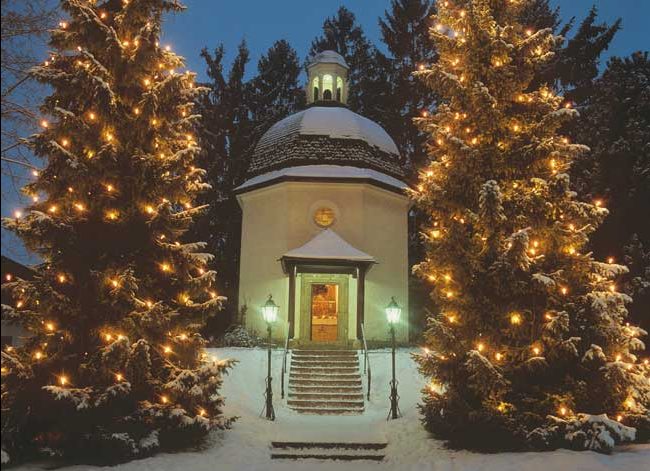
THE CAROL THAT RESCUED A FAILING CHRISTMAS
Can a crisis evoke from us a one-shot pinnacle of creativity?
In the case of two Austrian villagers exactly 200 years ago, the answer is an emphatic yes. It was in the small church of Oberndorf, Austria, near Salzburg, readying for the gala Christmas Eve service. The all-important pipe organ broke down, with no chance for repairs being done in time. To compensate for the crisis, the young priest Josef Mohr pulled out his poetic text now known as the sacred lullaby “Silent Night,” calming words for the Christ child in the manger, “Sleep in heavenly peace.”
He passed these along to the village school-teacher Franz Gruber, who was suddenly the superfluous church organist. The very same day Gruber (1787-1863) produced the music to fit the voices—equally straight-forward, but uniquely memorable. He scored it for a pair of soloists, chorus and the best substitute instrument available, the guitar. Gruber called his effort “a simple composition.”
The parishioners crowded in that night were treated to the world premiere of a work with singers who had barely had time to rehearse.
Later the work was taken up by the Strasser Sisters singing group specializing in Tyrolean music, as well as the Rainers. It became a hit all over the touring itineraries, eventually attributed to the eminent composer Michael Haydn (brother of Franz Josef Haydn). Who, after all, would believe that two village nobodies could create great music? After 15 years it was finally published, and another six years later was already being heard in New York City.
For decades uncertainty reigned about the carol’s creators. It took a court-room trial 26 years after the premiere to establish the truth, when Gruber’s son brought in a copy of the original manuscript to prove the true authorship before a governmental investigation committee. Case closed.
Any thoughts that Gruber-Mohr could become the Austrian Rodgers and Hammerstein, or Lerner-Loewe, would be sheer fantasy. After 1818 they went their separate ways, given the usual moves and transfers, and never produced other significant works. It was sheer coincidence that the two were together at all; Mohr (1792-1848) had been sent to Oberndorf from his earlier posting because his delicate health could not cope with a harsh climate.
Shortly before the Millennium, the sole manuscript regarding the carol’s origins was discovered, written in Mohr’s handwriting, dating back to 1820 or thereabouts. He attested that he had written the texts in 1816, with the music composed by Gruber in 1818.
The lesson here is profound and invaluable: The Mozarts and Leonardos of our world could be brilliant every single day. As for the rest of us, however mediocre in the greater scale of things, we could still rise up once in full flower, like a century plant. We could create something uniquely masterful, provided we possess the will, the faith and the motivation.
From adversity comes the flowering of inspiration. And a catalytic pairing doesn’t hurt, either.